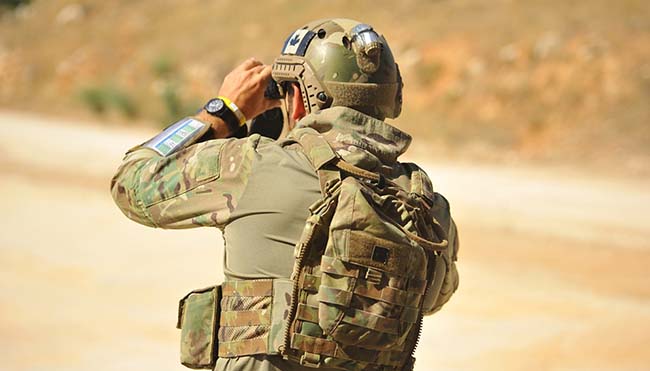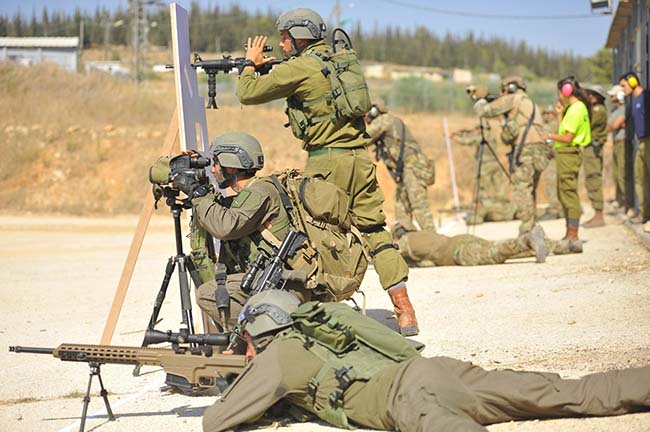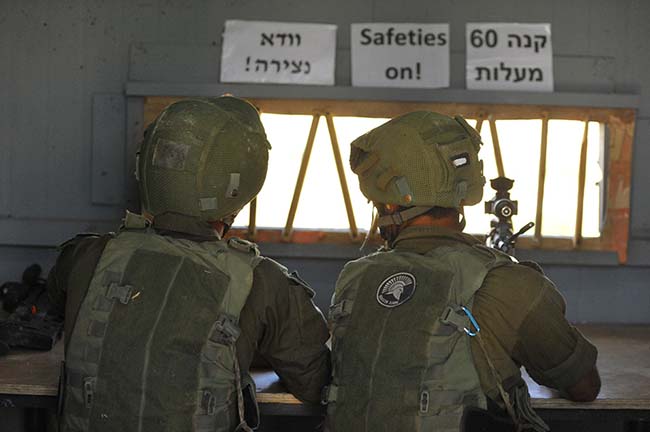ABOVE: U.S. Army Sniper Course Instructors competing in the target detection event.
Along white, sun-burned hilltops outside the city of Modi’in, snipers from around the world convened in July at Camp Adam to compete in the 5th annual Israeli Defense Force sniper competition. This was the first year of the competition that had competitors from different nations compete alongside IDF’s best and brightest combat tested snipers.
The IDF sniper competition isn’t your ordinary competition. Each stage is meticulously planned to emphasis the skills needed to succeed at combat; for with every passing day, the IDF is deployed along the borders of Israel, protecting their homeland from those who wish to do harm upon the state of Israel. The IDF’s mission is to defend the existence, territorial integrity and sovereignty of the state of Israel; to protect the inhabitants of Israel and to combat all forms of terrorism which threaten the daily life of Israelis. The IDF is built upon the principles of speed, aggression, and audacity. A sniper commander who is in charge of a three-man sniper team, does not expect the luxury of being able to appeal for instructions to higher command. He is on his own and his training allows him make decisions in the field without hesitation.
The counter-terrorism school located at Camp Adam was founded in 2012, and is divided into three sections: counter-terrorism, marksmanship, and sniper training. It trains both elite soldiers and ordinary infantry forces. Its staff members instruct others in combat, but also take part in counter-terrorism missions themselves on a regular basis. The IDF use their snipers in three distinct roles and applications; infantry, reconnaissance and counter terrorism operations.
The role of the infantry sniper has them operating as part of an infantry company or platoon. The sniper patrols within the formation with a patrol rifle and carries a sniper rifle in their pack. The sniper serves in the role of a rifleman until the need arises for the sniper to deliver long range accurate fire. This need may present itself in the form of harassing fire by the enemy from a distance that exceeds the maximum effective range of the patrol rifle. The sniper can also be used in sentry positions or in support by fire positions during the assault. The capabilities of the IDF infantry sniper is to deliver long range, precision, and discriminate fires, therefore minimizing potential collateral damage.
The IDF uses their snipers in a reconnaissance role similar to the way the U.S. military does. The biggest difference is the employment and use of camouflage by the sniper. Rather than training in ghillie suits or concealment hoods, they will employ thermal defeat blankets and carry decoy devices that mimic their surroundings. In the U.S. Army for example, they train their sniper to blend in with their backgrounds by utilizing negative space and obscuration. The IDF will employ those techniques but will also use geometrically shaped camouflage devices i.e. the Zikitec Cobweb, to simulate a rock. This use of the positive space allows them more camouflage possibilities.
The counter terror (CT) role of a sniper usually falls within the responsibility of the IDF Special Forces. In a CT formation the sniper is part of an intervention team. This team is comprised of one commander, two to three marksmen, two breachers, one machine gunner, one dog handler, one medic, one sergeant, three rifleman, and two snipers. The goal of the intervention team is to respond to a terror attack or high-profile situation and then isolate the area. The CT sniper is trained to take highly accurate incapacitation shots in order to free hostages or eliminate embedded hostiles. They carry the additional mission of protecting the borders in areas such as the West Bank. To accomplish that mission, they employ an accurized Ruger 10/22, which is a .22cal rifle. This accurized “less lethal” weapon is designed for taking knee cap and below shots.

Lying like lions in the sand, who at any moment, are ready to attack, nine three-man sniper teams from seven different nations, and thirty-two three-man teams from the IDF Infantry, Reconnaissance, and Special Forces battled it out in an intense three-day competition to crown the winner; champion of champions. The events of the competition aimed to depict operational situations which are relevant to combat snipers.
DAY ONE
After receiving the welcoming brief from the Sniper Department Commander of the IDF, competitors were assigned to squads, as this facilitated in less wait times between each stage, as each squad went off to separate stages, then switched once that stage was complete. Day one consisted of; two day stages and one night stage. The first day stage was an unknown distance stage that had competitors engage three human size steel targets at unknown distances from inside a building, in which the competitors had to build a stable firing platform and engage the targets through a window. One of the unique challenges of the competition was the team structure. In the IDF, they employ a three-man team consisting of; a shooter, a spotter, and a commander. Both the shooter and spotter utilize sniper rifles, and the commander carries a patrol rifle and is the one who authorizes the use of force and assists in spotting for each team member. For some of the international teams, they had to adapt to this team structure and work together to be successful. After engaging the unknown distance targets, the sniper teams exited the building and ran roughly 100 meters to a large dirt berm and had to engage a moving target that was being suspended by a drone. An Israeli defense company has been working with the IDF sniper department in creating a portable, and dynamic moving target for training purposes. The drone being used was of commercial size and had an average flight time of 45 minutes. The drone is able to travel along varying terrain and suspend a target that the snipers can engage. The drone operates off GPS and is able to move from point to point as deemed by the operator. The varying speeds and changing of directions were a humbling experience for each sniper team, but as the teams came off the firing line, they all agreed that it was a great device that mimics the lifelike characteristics of a human target; who runs, jumps, and takes cover on the battlefield.
The night stage of day one was a test of the team’s ability to quickly find four targets at various ranges, some of which were partially obscured by cover, and engage each target with only two rounds in six minutes. The catch was that the sniper team had to engage the targets while firing from behind a window and from a shooting tripod. The windows were small, and it forced the teams to adapt and precisely communicate with each other by voice commands and the use of their infra-red lasers. Teams that were able to quickly find the targets and illuminate the targets with their IR lasers and IR floodlights were the most successful. After the completion of day one, it was Israeli’s Maglan unit in first place, United States Army Sniper Course in second, and Israeli’s Shayetet 13 rounding out third.
Sayeret Maglan
Sayeret Maglan is an Israeli special forces unit which specializes in operating behind enemy lines and conducting deep reconnaissance in enemy territory. These elite members have gone after some of the worst terrorists in the West Bank and Gaza strip. Maglan was established in June 1986 as an elite unit specializing in anti-tank warfare using advanced weapons and is part of the Commando Brigade. During the Second Lebanon War, Maglan operatives oversaw the destruction of Hezbollah command sites, caches of ammunition, vehicles, and infrastructure.
Shayetet 13
Shayetet 13 is a unit within the Israeli Navy and is one of the primary special operation units of the IDF. The Shayetet 13 specialize in sea-to-land incursions, maritime intelligence collection, hostage rescue, counter-terrorism, and vessel boarding. Service in the unit combines long and comprehensive infantry training with specialization in marine warfare, diving, and the operation of special vessels. The unit has won Israel’s Chief of Staff’s award several times for its contribution to fighting terror and for developing innovative operational capabilities. The unit has participated in every war Israel has fought in, and are some of the most battle-tested men in modern times.
DAY TWO
Day two would be the most strenuous and exhausting day for the competitors as there were five day stages and two night stages. The hardest day stage for the competitors was the patrol stage. This stage had the entire squad of competitors (groups of ten) move as one unit over hilly terrain, in which they would come to a firing point and be given a time limit and the position that they could shoot from. At every firing point, there were three target lines for the competitors to shoot at. Two of target lines were stationary steel targets and the third was a row of popper targets that would expose themselves for only a few seconds at a time. Competitors had to engage the steel targets in sequence then engage the pop-up targets. As the sun rose over the sun-bleached hilltops, each team was feeling the pressure to perform. The teams that did the best were the ones who rehearsed setting up their equipment in a timely manner and who communicated in clear and precise instruction to the shooter, who waited feverishly on the spotter and commander to range the targets and make a wind call.
One event that didn’t consist of firing a single shot was an observation drill that challenged the sniper teams in target detection. This event tested the sniper’s ability to locate, identify, and record five military items that were hidden in a mocked-up village. The teams had ten minutes to complete the event, with points given for time and for items found. Target detection is a critical skill of the sniper. Snipers must locate, identify, report, and respond to critical information that they might encounter on the battlefield. Accurate reporting, and visual control over an enemy area is paramount to the success of the mission.
DAY THREE
The final day of the event had only one stage, and with the top competing teams vying for that coveted first place finish, pressure was building up and the teams that could focus and execute came out on top. The final event simulated a sniper team setting up a position in a confined urban area, similar to an alleyway. The teams had to enter a structure and engage moving and stationary targets out to 600 meters, but the caveat was that the sniper only had a limited field of view and the spotter and commander had to communicate with the sniper when a target popped up or when it was moving back into their field of view. If that wasn’t enough, the targets were being exposed behind plywood structures that the school cadre built, so the sniper teams had only a few seconds to engage the targets before the target went back behind cover.
After the dust had settled, scores were compiled and the IDF Sniper Department was ready to announce the top teams. In third place was Instructors from the United States Army Sniper Course, in second place was members of the United States Navy Seals, and in first, members from Israel’s Maglan unit.
The IDF International sniper competition was executed flawlessly thanks to the many reserve and active duty Soldiers of the IDF. All the men and women who helped make this event possible deserve the upmost admiration. A quick description of what it takes to be an elite IDF sniper instructor is that all sniper instructors complete a two-and-a-half-month course which is specifically for sniper instructors. The majority of the female instructors complete a two-month course which trains them to be Infantry Unit Instructors. As for male instructors, the majority come from a background of combat training, and most have completed an intense one-to-two year-long training path. Those instructors both instruct courses and are also active operationally. They are part of the IDF Sniper Department’s Sniper Squad who take an active role in the West Bank and Gaza strip.
Over the course of three days, these instructors embodied the professionalism of what the IDF stands for and every competitor left there with lessons learned and new friendships formed. Toda Raba!











